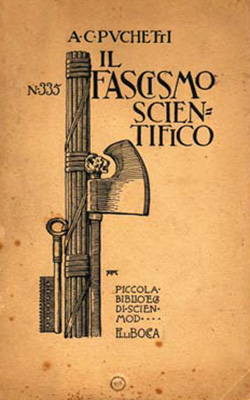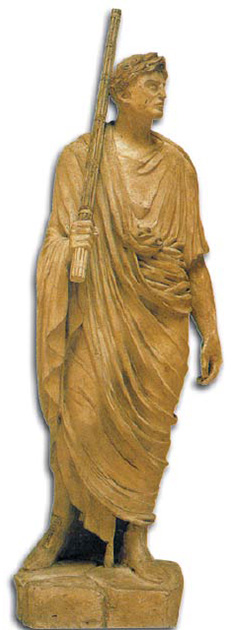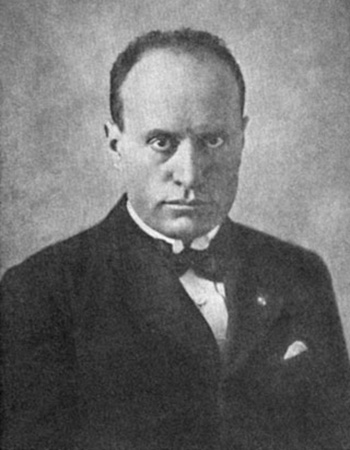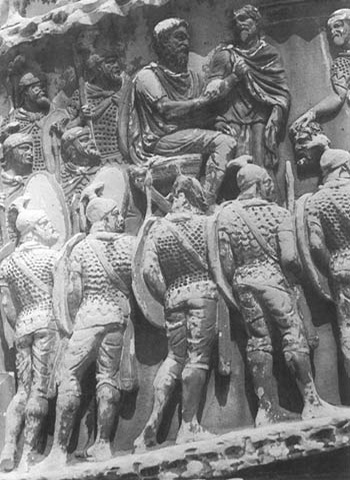 |
| Mussolini adopted the Roman axe to symbolize his power. Above is an Italian magazine of the time, entitled Il Fascismo Scientifico (Scientific Fascism). |
Fascism is an oppressive political movement that first developed in Italy after 1919, and then in various countries in Europe, as a reaction to the political and social changes brought about by World War I. The name comes from the Latin word fasces, meaning a bundle of rods tied around an axe which symbolized authority in ancient Rome.
 |
| A lictor from ancient Rome. He walked in front of Roman magistrates and held a bundle of rods in his hand as a symbol of power and authority. |
The term "fascism" was first used in Italy by the 1922-1924 government led by Benito Mussolini. And the figure of a bundle of sticks tied around an axe became the emblem of the first fascist party. After Italy, fascist governments came to power in Germany from 1933 to 1945, and in Spain from 1939 to 1975. After World War II, dictatorial regimes set up in South America and other undeveloped countries were generally described as fascist.
To understand the philosophy of fascism, we may consider the description that Mussolini wrote for the Italian Encyclopedia in 1932:
Fascism, the more it considers and observes the future and the development of humanity quite apart from political considerations of the moment, believes neither in the possibility nor the utility of perpetual peace. It thus repudiates the doctrine of Pacifism—born of a renunciation of the struggle and an act of cowardice in the face of sacrifice. War alone brings up to its highest tension all human energy and puts the stamp of nobility upon the peoples who have courage to meet it. All other trials are substitutes, which never really put men into the position where they have to make the great decision—the alternative of life or death.... [The Fascist] conceives of life as duty and struggle and conquest, but above all for others—those who are at hand and those who are far distant, contemporaries, and those who will come after.1
 |
| The first fascist dictator of the 20th century: Benito Mussolini, ruled Italy between 1922 and 1944. |
Evidently, the main idea behind fascism, as stressed by Mussolini, is Darwinist conflict and war. For, as we saw in the foreword, Darwinism claims that "the strong survive, the weak are eliminated," for which reason it suggests that people need to be in a constant state of struggle in order to survive. Fascism, having been developed from this idea, promotes the belief that a nation can only advance through war, and regards peace as an element that retards progress.
The same line of thought was expressed by Vladimir Jabotinsky, widely regarded as one of the foremost representatives of Zionist Jews, and proponent of the Israeli radical right, who summed up the fascistic ideology in a statement he made in the 1930s:
Stupid is the person who believes in his neighbor, good and loving as the neighbor may be. Justice exists only for those whose fists and stubbornness make it possible for them to realize it . . . Do not believe anyone, be always on guard, carry your stick always with you—this is the only way of surviving in this wolfish battle of all against all.2
As is evident from these words, and as we shall be seeing in some detail in the pages that follow, fascism is actually an ideology that is set in accordance with "the law of the jungle" as developed by Darwinism.
 |
Another feature of fascism to consider is that it is a nationalistic and aggressive ideology based on racism. This nationalism is far removed from mere love of country. In the aggressive nationalism of fascism, one aspires to see his own nation dominating others, and utterly humiliating them, and has no compunction about inflicting great suffering upon its own people in the process. Moreover, fascistic nationalism consists of using war, occupation, massacre and bloodshed as tools towards such political aims.
In the same manner as fascist regimes use such means to dominate other nations, they also use force and oppression against their own nation. Fascism's basic social policy is insistence on an idea, and obliging people to accept it. Fascism aims at making individuals and all of society think and behave in the same way. In order to attain this end, it uses force and violence along all kinds of methods of propaganda. It denounces as an enemy anyone who does not comply with its ideas, even going as far as genocide, as in the case of Nazi Germany.
The above has been just a brief description of the nature of the social structure and political structure of fascism. But the real problem is in identifying where the idea of fascism was born, how it then spread, came to power, and took hold of entire nations. It is important to understand these, because, although people think that fascism was done away with at the end of World War II, it still rears its head in a number of forms. Fascism is not just a political system, it is also a mentality, and even if this mentality no longer leads to the establishment of political regimes, such as Nazi Germany, or Mussolini's Italy, it nevertheless continues to inflict suffering on people all over the world.
So we shall now examine the roots of the fascist mentality, and how it was able to grow in strength to the point of outraging the whole world in the first half of the 20th century, and fill it with suffering.
 |
| 1., 2.Mussolini's Fascist Party emblem and flags. A bundle of rods bound together around an axe is the common form of fascist emblems. 3. The axe and a bundle of rods symbolizing fascism in an illustration with Mussolini's signature. |